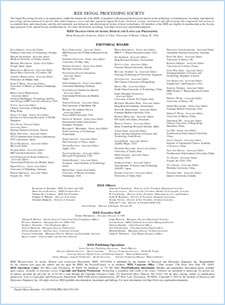- Our Story
- Publications & Resources
- Publications & Resources
- Publications
- IEEE Signal Processing Magazine
- IEEE Journal of Selected Topics in Signal Processing
- IEEE Signal Processing Letters
- IEEE Transactions on Computational Imaging
- IEEE Transactions on Image Processing
- IEEE Transactions on Information Forensics and Security
- IEEE Transactions on Multimedia
- IEEE Transactions on Signal and Information Processing over Networks
- IEEE Transactions on Signal Processing
- IEEE TCI
- IEEE TSIPN
- Data & Challenges
- Submit Manuscript
- Guidelines
- Information for Authors
- Special Issue Deadlines
- Overview Articles
- Top Accessed Articles
- SPS Newsletter
- SigPort
- SPS Resource Center
- Publications FAQ
- Blog
- News
- Dataset Papers
- Conferences & Events
- Community & Involvement
- Professional Development
- For Volunteers
- Information for Authors-OJSP
-
Home
Waveforms for Computing Over the Air: A groundbreaking approach that redefines data aggregation
Ode to Masterfully Written Textbooks: And remembering Simon Haykin [From the Editor]
Conferences Events IEEE Signal Processing Magazine IEEE SPL Article IEEE TIFS Article IEEE TMM Article IEEE TSP Article Jobs in Signal Processing Lectures Machine Learning Seasonal Schools Signal Processing News SPM Article SPS Distinguished Lectures SPS Newsletter Article SPS Webinar SPS Webinars SPS Webinar Series Webinar webinars -
Our Story
What is Signal Processing?

The technology we use, and even rely on, in our everyday lives –computers, radios, video, cell phones – is enabled by signal processing. Learn More » -
Publications & Resources
-
SPS Resources
- Signal Processing Magazine The premier publication of the society.
- SPS Newsletter Monthly updates in Signal Processing
- SPS Resource Center Online library of tutorials, lectures, and presentations.
- SigPort Online repository for reports, papers, and more.
- SPS Feed The latest news, events, and more from the world of Signal Processing.
-
SPS Resources
-
Conferences & Events
-
Community & Involvement
-
Membership
- Join SPS The IEEE Signal Processing Magazine, Conference, Discounts, Awards, Collaborations, and more!
- Chapter Locator Find your local chapter and connect with fellow industry professionals, academics and students
- Women in Signal Processing Networking and engagement opportunities for women across signal processing disciplines
- Students Scholarships, conference discounts, travel grants, SP Cup, VIP Cup, 5-MICC
- Young Professionals Career development opportunities, networking
- Get Involved
-
Technical Committees
- Applied Signal Processing Systems
- Audio and Acoustic Signal Processing
- Bio Imaging and Signal Processing
- Computational Imaging
- Image Video and Multidimensional Signal Processing
- Information Forensics and Security
- Machine Learning for Signal Processing
- Multimedia Signal Processing
- Sensor Array and Multichannel
- Signal Processing for Communication and Networking
- Signal Processing Theory and Methods
- Speech and Language Processing
- Technical Working Groups
- More TC Resources
-
Membership
-
Professional Development
-
Professional Development
- Signal Processing Mentorship Academy (SigMA) Program
- Micro Mentoring Experience Program (MiME)
- Distinguished Lecturer Program
- Distinguished Lecturers
- Distinguished Lecturer Nominations
- Past Lecturers
- Distinguished Industry Speaker Program
- Distinguished Industry Speakers
- Distinguished Industry Speaker Nominations
- Industry Resources
- IEEE Training Materials
- Jobs in Signal Processing: IEEE Job Site
-
Career Resources
- SPS Education Program Educational content in signal processing and related fields.
- Distinguished Lecturer Program Chapters have access to educators and authors in the fields of Signal Processing
- Job Opportunities Signal Processing and Technical Committee specific job opportunities
- Job Submission Form Employers may submit opportunities in the area of Signal Processing.
-
Professional Development
-
For Volunteers
-
For Board & Committee Members
- Board Agenda/Minutes* Agendas, minutes and supporting documentation for Board and Committee Members
- SPS Directory* Directory of volunteers, society and division directory for Board and Committee Members.
- Membership Development Reports* Insight into the Society’s month-over-month and year-over-year growths and declines for Board and Committee Members
-
For Board & Committee Members
Popular Pages
Today's:
- Congratulations to Signal Processing Society Members Elevated to Senior Members!
- Information for Authors
- Jobs in Signal Processing
- Update on the 2025 SPS Annual General Election Schedule
- (ASRU 2025) 2025 IEEE Automatic Speech Recognition and Understanding Workshop
- Inside Signal Processing Newsletter
- Membership
- Submit a Proposal for ICASSP 2030
- Meet SPS Member Ahmet Mete Elbir
- IEEE Transactions on Information Forensics and Security
- SPS Members Receive 2026 IEEE Technical Field Awards!
- Unified EDICS
- Information for Authors-SPL
- New Editor-in-Chief (EIC) of the IEEE Transactions on Multimedia (T-MM)
- IEEE Transactions on Multimedia
All time:
- Information for Authors
- Submit a Manuscript
- IEEE Transactions on Image Processing
- IEEE Transactions on Information Forensics and Security
- IEEE Transactions on Multimedia
- IEEE Transactions on Audio, Speech and Language Processing
- IEEE Signal Processing Letters
- IEEE Transactions on Signal Processing
- Conferences & Events
- IEEE Journal of Selected Topics in Signal Processing
- Information for Authors-SPL
- Conference Call for Papers
- Signal Processing 101
- IEEE Signal Processing Magazine
- Guidelines
Last viewed:
- (ASRU 2025) 2025 IEEE Automatic Speech Recognition and Understanding Workshop
- Award Recipients
- Information for Authors
- Awards & Submit Award Nomination
- Inside Signal Processing Newsletter
- A Comparative Study of Signal Processing Methods for Fetal Phonocardiography Analysis
- ByRDiE: Byzantine-Resilient Distributed Coordinate Descent for Decentralized Learning
- Congratulations to Signal Processing Society Members Elevated to Senior Members!
- IEEE Signal Processing Magazine
- (ICIP 2026) 2026 IEEE International Conference on Image Processing
- Information for Authors-SPL
- IEEE TMM Special Issue on Large Multi-modal Models for Dynamic Visual Scene Understanding
- Publications
- Personal Sound Zones by Subband Filtering and Time Domain Optimization
- Board of Governors
Personal Sound Zones by Subband Filtering and Time Domain Optimization
You are here
Publications & Resources
For Authors
Top Reasons to Join SPS Today!
1. IEEE Signal Processing Magazine
2. Signal Processing Digital Library*
3. Inside Signal Processing Newsletter
4. SPS Resource Center
5. Career advancement & recognition
6. Discounts on conferences and publications
7. Professional networking
8. Communities for students, young professionals, and women
9. Volunteer opportunities
10. Coming soon! PDH/CEU credits
Click here to learn more.
Personal Sound Zones by Subband Filtering and Time Domain Optimization
Personal Sound Zones (PSZ) systems aim to render independent sound signals to multiple listeners within a room by using arrays of loudspeakers. One of the algorithms used to provide PSZ is Weighted Pressure Matching (wPM), which computes the filters required to render a desired response in the listening zones while reducing the acoustic energy arriving to the quiet zones. This algorithm can be formulated in time and frequency domains. In general, the time-domain formulation (wPM-TD) can obtain good performance with shorter filters and delays than the frequency-domain formulation (wPM-FD). However, wPM-TD requires higher computation for obtaining the optimal filters. In this article, we propose a novel approach to the wPM algorithm named Weighted Pressure Matching with Subband Decomposition (wPMSD), which formulates an independent time-domain optimization problem for each of the subbands of a Generalized Discrete Fourier Transform (GDFT) filter bank. Solving the optimization independently for each subband has two main advantages: 1) lower computational complexity than wPM-TD to compute the optimal filters; 2) higher versatility than the classic wPM algorithms, as it allows different configurations (sets of loudspeakers, filter lengths, etc.) in each subband. Moreover, filtering the input signals with a GDFT filter bank (as in wPM-SD) requires lower computational effort than broadband filtering (as in wPM-TD and wPM-FD), which is beneficial for practical PSZ systems. We present experimental evaluations showing that wPM-SD offers very similar performance to wPM-TD. In addition, two cases where the versatility of wPM-SD is beneficial for a PSZ system are presented and experimentally validated.
SPS Social Media
- IEEE SPS Facebook Page https://www.facebook.com/ieeeSPS
- IEEE SPS X Page https://x.com/IEEEsps
- IEEE SPS Instagram Page https://www.instagram.com/ieeesps/?hl=en
- IEEE SPS LinkedIn Page https://www.linkedin.com/company/ieeesps/
- IEEE SPS YouTube Channel https://www.youtube.com/ieeeSPS
Home | Sitemap | Contact | Accessibility | Nondiscrimination Policy | IEEE Ethics Reporting | IEEE Privacy Policy | Terms | Feedback
© Copyright 2025 IEEE - All rights reserved. Use of this website signifies your agreement to the IEEE Terms and Conditions.
A public charity, IEEE is the world's largest technical professional organization dedicated to advancing technology for the benefit of humanity.











